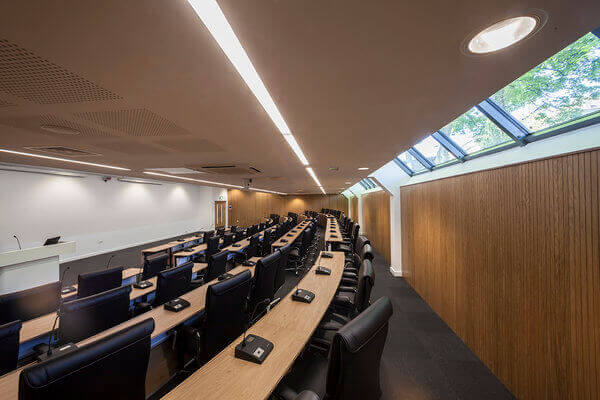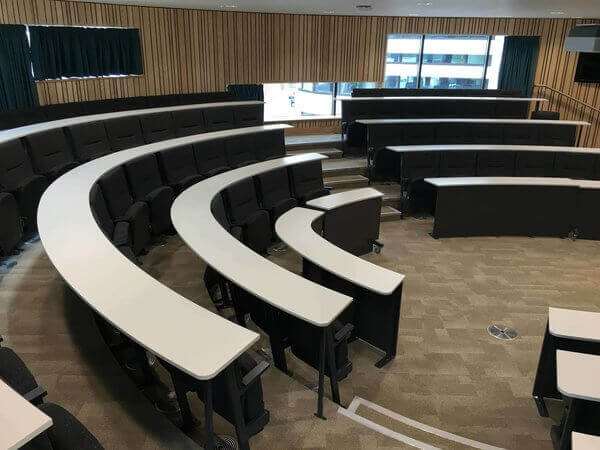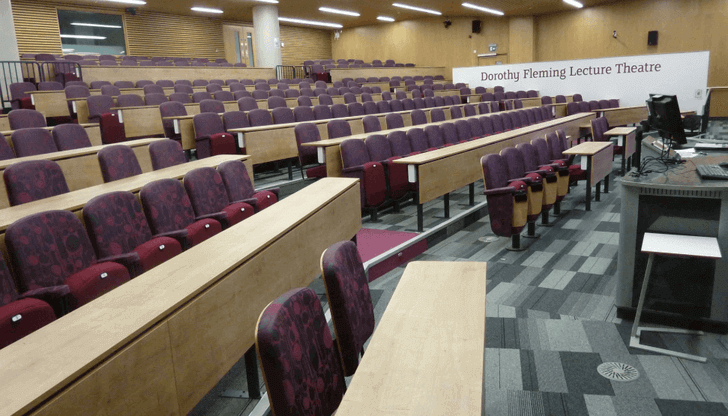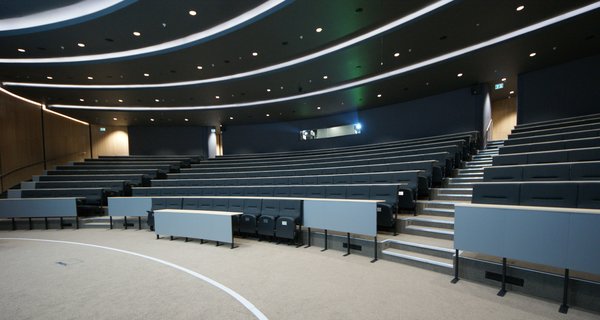Lecture theatre design is a very tricky thing to get right. Your auditorium will serve a number of purposes over the years from informative lectures, interactive sessions and gatherings with guest speakers amongst other things.
Why is lecture theatre design important?
The design of a lecture theatre can have a significant impact on the learning experience of students and other attendees in the audience.
The environment of a lecture theatre is far removed from that of a classroom. Classrooms are far more intimate with a deeper level of 1:1 interaction between tutor and pupil. Lectures involve a far greater amount of performer and audience relationships therefore, requiring a very different dynamic.
Lecture theatre designs need to incorporate a way of ensuring each and every member of the audience can still interact with the presenter. Who must stimulating an audience often up to thousands of people.
Lecture theatre seating essentials
Visibility
Raked Seating is an important part of any lecture theatre arrangement. Having a clear line of sight to the stage and presenter is essential for any member of your audience. In the presenter to audience relationship normally associated with a lecture theatre design. Not having a clear line of sight to both the presenter and the topic they are presenting on can have a direct correlation to the interest and participation of the audience members.
Durability
Your lecture theatre will hold thousands of people over the course of its lifetime. Figures from 2017-18 stated in excess of 2.34 million students were in higher education in the UK, these figures are thought to have grown since with over 500,000 new entrants to higher education in 2018.
The majority of universities in the UK have student numbers in excess of twenty thousand with the likes of the University of Manchester recording over 40,000 students enrolled at any time. With such a large number of students to accommodate in lecture theatres, seminar rooms and workshop environments, the durability of lecture theatre seating is paramount to a successful design.
Acoustic design
Alongside visibility and comfort, it is hugely important your audience can hear the presenter. The acoustics of your lecture room design are not as easy to plan as you may believe, the surfaces and angles of a room must be engineered towards the purpose of the auditorium. The acoustic requirements of a music performance hall will greatly differ from that of space hosting a single guest speaker for example.
If your room is to be multi-purpose, it is worth discussing your requirements with an acoustic engineer.
Space planning
There are a number of factors and considerations when planning your lecture theatre design. The amount of space you have and the purpose of the seating will go a great way to determine the types of seating you can have. There are a range of components available alongside the style and fabric of your seating will define your theatre for all who use it. So what are your options?
Fixed or retractable
Depending on the amount of space you have or the variety of uses your auditorium has. You may choose to go for a retractable seating option. For many of the large universities we work with, their lecture theatres are purpose-built to just be lecture theatres. These suit a large and fixed tier lecture theatre design.
Other smaller universities and colleges across the country often require a more flexible approach. Their auditoriums are multi-purpose to suit the needs of many interests throughout the establishment. Here, a retractable seating unit can benefit, saving space and budget in the longer-term.

University of Sheffield – Management School
Integrated technology
Technology is becoming an integrated part of life more and more, higher education classroom and lecture theatre design is no different. A new wave of undergraduates are more tech-savvy then the previous generations and the next generation will be even more so.
Power sockets can be added along with microphones and engagement tools to increase audience participation with the event or presentation. The picture above shows a design we added to the lecture theatre at the University of Sheffield’s Management School.
As with a number of areas, change is slow in adding technology to lecture theatres and lecture seating. Lecture theatres are not changed regularly, the logistics and expense of replacing an entire lecture theatre with capacity into the hundreds is not a task for each summer between academic years. This gives a great opportunity for universities and colleges to get ahead of the curve and become a leader. Offering an option to students they can not get at the other higher education institutes they are thinking of using.
This is exactly what we helped Sheffield Hallam University do with their new Charles St building Lecture Theatre. We helped them install an interactive lecture theatre design pushing their offing beyond the curve for local institutions.
Desk space
There are a number of ways to utilise desk space in a lecture theatre design depending on your requirements. We offer a range of LT chairs with writing ledges both with and without modesty panels for the front rows. Ledges can be fixed as a traditional lecture theatre or folding to allow a larger ledge and more clear space between seats when folded up. These offer a stable space for notepads and laptops during lectures and a stylish finish to your new design.
If writing ledges aren’t for you, our LT9 seating units come equipped with individual tables which fold down between each seat for a clever space saver.
Core subjects
The purpose of your lecture theatre will determine the other factors of it. We have designed lecture theatres to be just that, a room where any subject can be displayed to a core group of students on mass. We have also designed lecture theatres to be used in more practical environments such as scientific vocations. These rooms often need to include areas for practical demonstrations and input from student. As a result, they come with very different requirements to traditional lecture theatres.
Lecture theatre seating plan
Choosing the seating plan and layout of your theatre can be the hardest design factor of all. Traditional use of straight tiered rows of seats is common with many institutions. While some are now opting for the use of Harvard Lecture Theatre designs and other similar modern options.
The Harvard design is great for a closer, more intimate lecture theatre with small groups. To increase interaction and two-way participation between lecturer and pupil the curved design from the famous American college is proven.

Harvard Lecture Room Design
Need help with lecture hall design?
Auditoria Services offer lecture theatre design solutions, tailored to your specifications and requirements.
We provide flexibility of choice in quantity of rows, rails, materials, finishes, technology and more. Our lecture theatre seating provides the perfect solutions for universities, colleges, academies and schools across the UK. We have installed lecture chairs in a range of educational institutes including Sheffield Hallam University, the University of York, the University of Sussex and many more.
Contact a member of our design team to discuss the best ways to utilise the spaces in your lecture theatre to engage students for years to come.






Comments are closed.